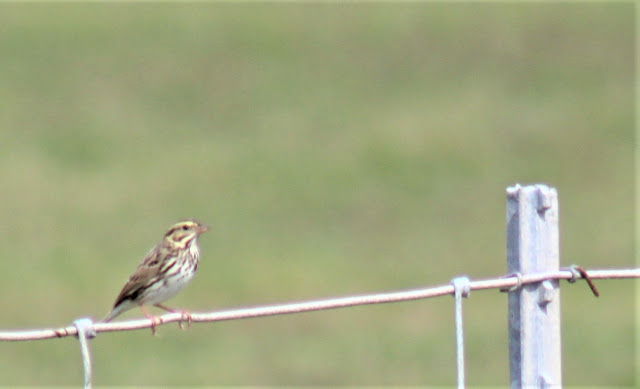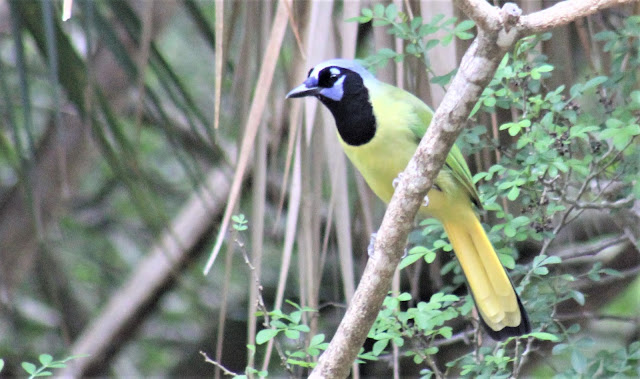I was up and breakfasted in time to meet the 6 a.m. bus for the Rio Grande Valley Birding Festival trip to the King Ranch, led by Ranch employee Tom Langscheid with assistance from Neil Hayward, Jennie Duberstein and hawk expert Bill Clark.
From the Festival brochure: "The King Ranch is a magical place: One of the largest ranches in the world (larger than the state of Rhode Island). It is also private property, with limited access for birders. The Norias Division, known for more resident Ferruginous Pygmy-Owls than anywhere else in the US, is only open to Festival participants at this time of year. The sandy soils of Norias support extensive areas of grasslands, thorn scrub and live oak woodlands, whose mottes hold the avian treasures we seek. Lead guides for this trip are specialists for the King Ranch and are passionate and knowledgeable about the role of the ranch and the wildlife it supports.”
We also stopped at a more open area, where we got great views of Sprague’s Pipit, which I had recorded as a “Heard Only” Life Bird back in Montana in May, hearing its distinctive vocalizations on a snowy morning. It’s always good to be able to change a Lifer from “heard-only” to a “crushed" view!
We returned to the convention center where I enjoyed seeing some of the bumper stickers of the (presumed) birders.
I had a bit of lunch, then took in a couple of talks. The first was Sometimes it Takes a Village: Nesting Harris’s Hawks in South Texas with Andrea Gibbons:Few birds defer their own reproduction to assist other breeding adults with the raising of their young, but the Harris’s Hawks of the Lower Rio Grande Valley are doing just that. Most nests in south Texas include at least one adult helping the primary breeders to rear offspring. Why do some hawks help? Let’s explore Andrea’s initial findings.
Harris’s Hawks, described by Andrea as “perhaps the coolest birds of prey in the South Texas region”, exhibit cooperative breeding in which more than two hawks are associated with an occupied nest. This phenomenon has been studied in Arizona and New Mexico, but results have been mixed and debated. Recent research by raptor connoisseur, Bill Clark, documented that at least 56% of the Harris’s Hawk groups in South Texas included one or more “extra” hawks attending nests. However, few of the breeding hawks that Bill observed were color marked and he was unable to determine the origin or the roles of extra hawks attending nests. With this project, we intend to employ modern science techniques and to finally solve the mystery of helper Harris’s Hawks at the nest! Importantly, understanding this mystery will provide key information in formulating conservation measures to ensure the unique social system of this very cool raptor is not disturbed by alteration of habitat or other human activities.To solve this mystery, Bill Clark has teamed up with researchers and students from University of North Texas (UNT) and Cornell University. These researchers have begun to trap and mark hawks with coded color bands, collect blood for DNA analysis, and put up time-lapse cameras at nests all in effort to determine if the helpers are returning young or are unrelated, as well as the evolutionary basis of this unique social strategy. Your donations will greatly help these researchers cover the costs of marking and monitoring hawks, doing the DNA analyses, and obtaining more nest camera systems to closely spy on the secret social interactions of Harris’s Hawks. Any contribution to this project will be greatly appreciated!This was followed up by: Sharp-shinned or Cooper’s, a Perplexing Raptor Field ID Problem with Bill Clark
One of the most difficult raptor identification problems in North America is figuring out whether an accipiter is a Sharp-shinned Hawk or a Cooper’s Hawk, whether perched or in flight. Bill’s talk will point out the many differences between these hawks in flight and perched. Dazzle your friends and up your game in the field!
I realized that I’ve likely been making a Lot of ID errors with these two species over the years, and am humbled by learning (re-learning) now what I should have known 40 years ago . . .
I walked through the vendor area, and had put my name into the jar for the King Ranch, winning a bill cap, as well as a ticket to the Ranch Hand Weekend Concert with Mark Chesnutt, which is part of the November 23rd celebration in Kingsville. I’ll end up giving the ticket to my daughter Becca, who lives in Texas and will enjoy the music.King Ranch eBird Checklist is Here






































